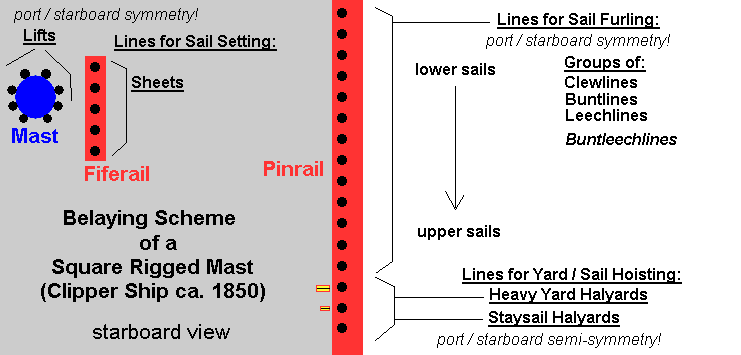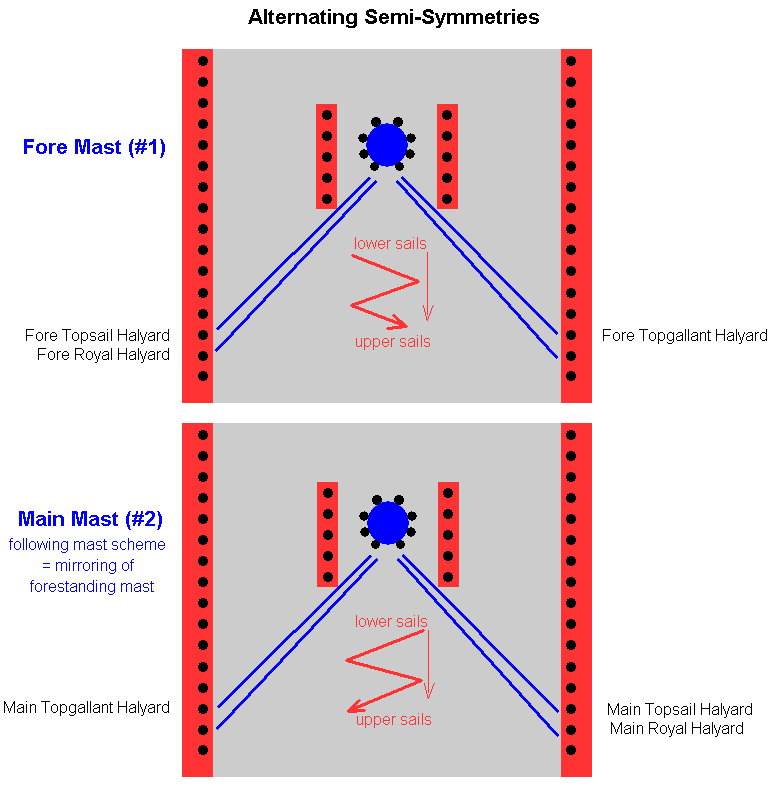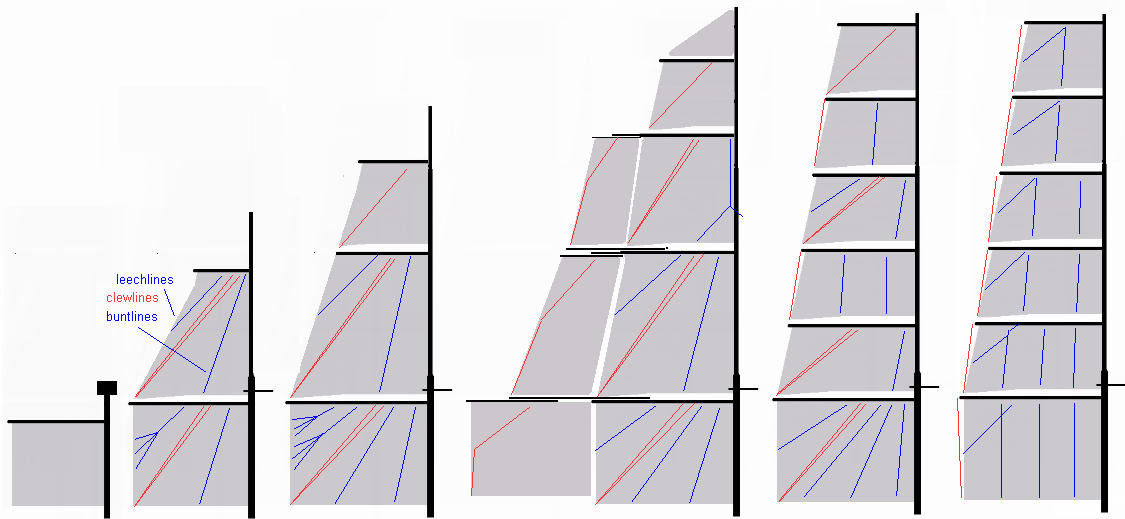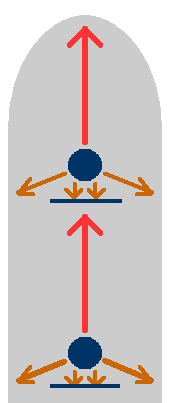Ship Modelling
Rigging Patterns - Buntlines and their Belaying Points
To the land lubbers: bunt lines are used to heave the lower bunt of the sail canvas up to the yard, to enable their furling.
They are attached in front of the sail only - not "around" it, and on old ships,
at the bunt once only; so the sail would "fold" and be half as long hanging down. The rest of the canvas is taken in by the hands
of the sailmen working on the yard.
The Lead of the RopesThese lines are visible on many depictions, both on photos and paintings, when they display the ship from the front or the side: leech- and buntlines on the fore side of the sails. The clewlines lead up on the aft side of the sails.
The Buntlines, over the centuries, became more, and also more sophisticated:
One change during the ages is remarkable indeed: until the 19th century, all clewlines, buntlines and leechlines went up to the center of the yard, and thus the sails were furled to the center, often just above the top and topgallant platforms. Then beginning around 1850, some sails had their clewlines leading up to the ends of the yards, and also the according buntlines leading up to the yards vertically. Today, all windjammers apply this "vertical pattern" on all square yards. The only line still going diagonal is the leechline. It was also around the 1850s when the topsails and topgallant sails were split into "upper and lower" topsails, for they became too large to handle and furl. By the same time, steel masts and yards also became applied, and the studding sails were no longer used. The later windjammers had so big sails that they used one or more small thimbles on the front face of the sail ... In numbers, the major part of all lines coming down from the masts are: bunt- and leechlines, with about 50% of the total running rigging. Belaying the Ropes: Patterns through the ErasIt is just one of these small details on deck ... the way how buntlines are attached to lower sails is very well known.
Belayings on Old Ships - The "British Pattern"There is an old, very important source of information: Steels´ "Elements of Mastmaking and Rigging" from 1794 (with many reprints). It is THE source of old ships with the highest historic "authority". It could be assumed that shipbuilders in Great Britain kept close to the rules and patterns presented in these books. There is a detail very different from "modern" sailing ships, namely with the clippers and windjammers: according to Steel, the lower buntlines (of the courses) lead foreward along the mast stay! Steel gives no information about exact pin positions to belay, so it can be only guessed that those line belayed on clamps on the stay, or on some knights or pins nearby around the mast foot of the forgoing mast. This pattern has been used also on the first North American sailing ships and frigates in the British colonies, for obvious reasons. One belaying scheme reconstruction of the USS Constitution (1797) (published only in "Modellers Shop Notes", plan by Edson/Vogel/Spicer) follows the same "British way". But that plan is a reconstruction by Spicer based on notes of Vogel, who in his turn based on reports of Edson. Nobody knows who of these, and how far, added his own considerations to alter the plan. After all, it is a traditional, historic pattern. I can recall how much I was amazed to see such a "strange" lead forward when I saw it for the first time. It was in Steels book, I have a reprint. I remember I could not believe it (I am continental, so to speak). "It cannot be!" I thought. "This does not work. The lines will move when the yard is braced, that makes no sense ..." Well ... I know that from a continental point of view, the British do have a number of "strange" traditions :) But not all British modellers follow Steel. When the master modeller C Napean Longridge built his giant model of the HMS Victory, in the 1960s, he let the lower buntlines go to the same mast where they came from, and published this in his book "The Anatomy of Nelson´ Ships" ... did he have a reason to decide "against" Steel, and apply a "Continental Pattern"? Would the lead of the main buntlines go directly forward along the main stay, it would be a problem: when the yard is braced into the wind, the buntlines of one side would be tight, and the other side very loose and could thus even damage the sail in the wind, so some sailors would be needed to adapt their belaying during the bracing - and this would be "unnecessary work" ... An adaption to the porblem would be, to have a number of blocks above the center of the yard, unter the top platform, and let the lines lead down from there. Then the yard bracing would cause no more problems ... The buntlines of the upper sails (the old topsails and topgallants ["tīgans"]) of the old ships were not many, contemporary depictions show regularly only 2 topsail buntlines and sometimes 2 topsail leechlines. The topgallant sails had only one buntline in the middle, or none at all. Old royal sails were even "flying", with nothing more than their halyard and the sheets; they were set in calm weather only. The lead down of those "upper lines" was never described, but it can be assumed that they were made fast around the same mast biss or rails; it is physically arbitrary, where exactly that was. Well, it is of course our modern rationalism that rules out anything "unnecessary". It could have been real in those times that this "unnecessary" work had in fact been done by some sailors who were onboard so many. These men were given even the dullest jobs, just to avoid boredom of doing-nothing, and thus to prevent giving people time to think about their poor situation; in order to prevent mutiny. It could also be that sailors themselves kept to these traditions for the sake of tradition as a sailors pride. Thus, developement of the rigging was very slow in these times. I cannot give a pattern picture here. There were too many different deck layouts, and too many variants and adaptions of the pinrails and bitts, with the size and the purpose of the ship (warship or merchant ship, large and small). Belayings on Old Ships - The "Continental Pattern"The "continental" rigging (of France and all other non-British navies) was, as far as we know, different here: those buntlines went down to the bitts and rails of the same mast that they come from. When no rails were in place at the sides of the ship, they installed shroud clamps instead. Again, I cannot give a pattern picture here. There were too many different deck layouts, and too many variants and adaptions of the pinrails and bitts, with the size and the purpose of the ship (warship or merchant ship, large and small). Belayings on "Modern" Sailing Ships - Clipper and Windjammer PatternsModern sailing ships - British and Continental =) - belay all their buntlines at the rails along the mast shrouds, or sometimes, the lower buntlines on a pin "somewhere" around the same mast; because these "XXXL"-lower sails can have up to 10 bunt- and leechlines. The modern sailing ships applied more "logic" schemes, and repeated them on almost all masts of the same rigging. Lines of the same type, which were moved together in the same direction (braces, clewlines and buntlines) were often grouped together for that very reason, in order no to mix them up with other lines serving a completely different part in the rigging.
In the 19th century, a typical square sail mast had the following arrangement:

A special detail is the arrangement of the yards halyards, forming a kind of semi-symmetry.
The next-upper halyard was belayed to the "other" side-rail, so we find an alternation
of the pins, "jumping" between port and starboard.
The order of alternation tradionally started with the (lower) topsail on the port rail (that is: to the left side) for the Fore mast.
The Main mast was a mirror of it, starting at starboard (to the right). And so forth, when the ship had more
square rigged masts...

but: other countries, other traditions. Some ships had the same scheme "unmirrored" applied on all masts. In reality, the sailors were instructed by the bosun knowing all the lines by heart. In those days, people and sailors (who often could not read) used no plans, but memorized everything they needed to know. That is why the knowledge had been almost lost for us today. |


